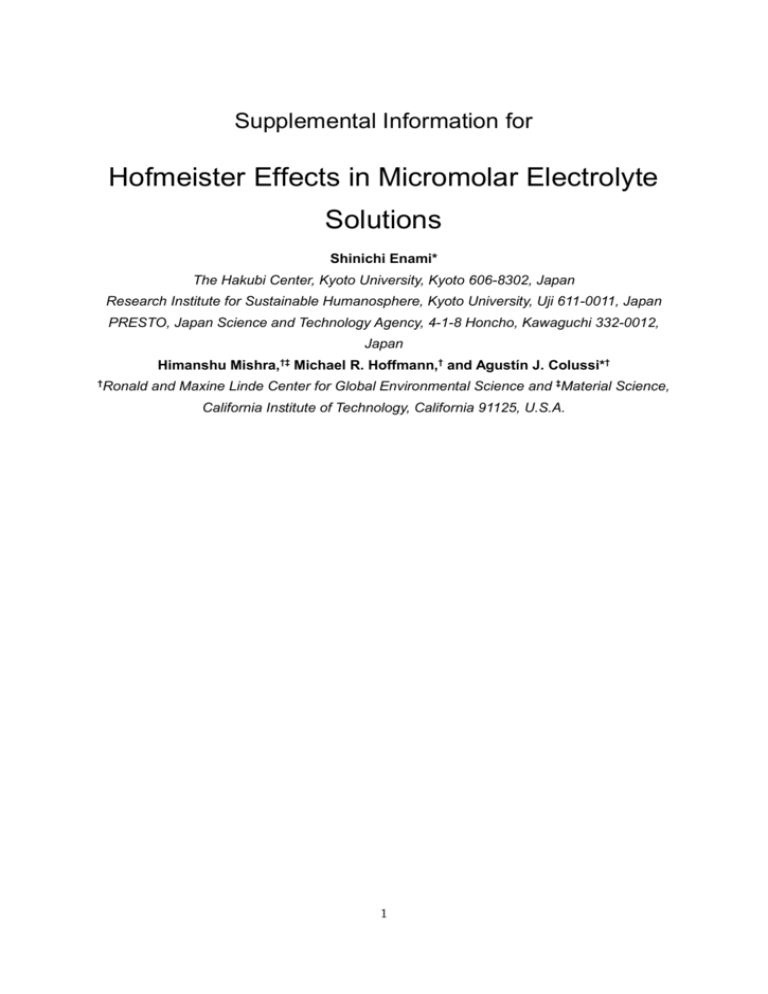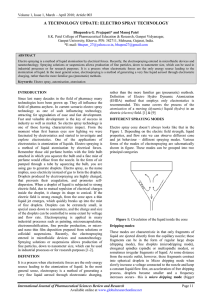JCP_SI_MARCH 6
advertisement

Supplemental Information for Hofmeister Effects in Micromolar Electrolyte Solutions Shinichi Enami* The Hakubi Center, Kyoto University, Kyoto 606-8302, Japan Research Institute for Sustainable Humanosphere, Kyoto University, Uji 611-0011, Japan PRESTO, Japan Science and Technology Agency, 4-1-8 Honcho, Kawaguchi 332-0012, Japan Himanshu Mishra,†‡ Michael R. Hoffmann,† and Agustín J. Colussi*† † Ronald and Maxine Linde Center for Global Environmental Science and ‡Material Science, California Institute of Technology, California 91125, U.S.A. 1 SI EXPERIMENTAL SECTION: Our experiments involve the generation of aqueous microjets in the spraying chamber of an electrospray ionization mass spectrometer (ESMS). Since mass spectrometers detect net charge, the first step is the separation of pre-existing anions from cations in the electroneutral inflowing solutions. This is accomplished via the pneumatic breakup of the aqueous jet by a fast nebulizer gas that shears the outermost jet layers into droplets carrying net charges of either sign. Such droplets have a distribution of sizes and net charges1,2 and, together, possess more surface and electrostatic energies than the original jet at the expense of the kinetic energy lost by the nebulizer gas. Since the nebulizer gas can fragment the jet but not the smaller droplets for hydrodynamic reasons,3,4 the creation of net charge is a one-time event. A critical feature of our instrument is that the jet issuing from the nozzle source is orthogonal to the polarized inlet to the mass spectrometer (see Figure S1). Therefore, the charged droplets deflected toward the mass spectrometer preferentially originate from the peripheral layers of the jet, while its core maintains its forward trajectory. The ejection of dissolved ions to the gas-phase takes place from the smallest droplets at the end of a sequence of events comprising extensive solvent evaporation, and net charge crowding in shrinking droplets that become unstable and undergo a cascade of Coulomb explosions.5,6 Gas-phase ions are sorted out and detected by the online mass spectrometer. Data analysis based on mass balances and the kinetic theory of gases7 suggest that the thickness of the interfacial layers sampled in these experiments is less than one nm.8,9 2 Conditions in the present experiments were: drying gas flow rate: 13 L min-1; drying gas temperature: 300 oC; inlet voltage: + 3.0 kV relative to ground; fragmentor voltage value: 80 V. NaI (purity > 99.5 %), KCl (> 99 %), CsCl (> 99 %), NH4Cl (> 99.5 %), N(C4H9)4Cl (> 95 %), NaClO4-H2O (> 98 %), HCl (35 % solution) and NaOH (10 N solution) were purchased from Nacalai Tesque. NaCl (> 99 %), NaNO3 (> 99 %), NaBr (> 99.5 %) and 2-propanol (> 99.9 %) were purchased from Sigma-Aldrich, Wako, Kanto Chemical and Fluka Analytical, respectively. All chemicals were used as received. All solutions were prepared in purified water (Resistivity ≥ 18.2 Mcm at 298 K) from a Millipore Milli-Q water purification system. All experiments were performed at 298 + 3 K. 3 Figure S1 Schematic diagram of the present ESMS experimental setup 4 1.5 I- 5 Signal intensity / 10 ion counts 2.0 Br 1.0 - 0.5 0.0 0 200 400 600 800 1000 [NaI+NaBr] / M 4.0 3.5 P127 / P79+81 3.0 2.5 2.0 1.5 1.0 1 10 100 1000 [NaI+NaBr] / M Figure S2 I- and Br- signal intensities from aqueous (NaI+NaBr) mixture jets as a function of (NaI+NaBr) concentrations (upper panel) and the semi-log plot of the I-/Brratio as a function of (NaI+NaBr) concentrations (lower panel). Fitting curves are guides for eye clarity. 5 REFERENCES 1 Dole, M. A theory of surface tension of aqueous solutions, J. Am. Chem. Soc., 60, 904-904, 1938. 2 Zilch, L. W.; Maze, J. T.; Smith, J. W.; Ewing, G. E.; Jarrold, M. F. Charge separation in the aerodynamic breakup of micrometer-sized water droplets, J. Phys. Chem. A, 112, 13352-13352, 2008. 3 Lasheras, J. C.; Villermaux, E.; Hopfinger, E. J. Break-up and atomization of a round water jet by a high-speed annular air jet, J Fluid Mech, 357, 351-351, 1998. 4 Gorokhovski, M. A.; Saveliev, V. L. Analyses of Kolmogorov's model of breakup and its application into Lagrangian computation of liquid sprays under air-blast atomization, Phys Fluids, 15, 184-184, 2003. 5 Iribarne, J. V.; Thomson, B. A. On the evaporation of small ions from charged droplets, J. Chem. Phys., 64, 2287-2287, 1976. 6 Kebarle, P.; Peschke, M. On the mechanisms by which the charged droplets produced by electrospray lead to gas phase ions, Anal. Chimi. Acta., 406, 11-11, 2000. 7 Davidovits, P.; Kolb, C. E.; Williams, L. R.; Jayne, J. T.; Worsnop, D. R. Mass accommodation and chemical reactions at gas-liquid interfaces, Chem. Rev., 106, 1323-1323, 2006. 8 Enami, S.; Hoffmann, M. R.; Colussi, A. J. Proton Availability at the Air/Water Interface, J. Phys. Chem. Lett., 1, 1599-1599, 2010. 9 Enami, S.; Stewart, L. A.; Hoffmann, M. R.; Colussi, A. J. Superacid Chemistry on Mildly Acidic Water, J. Phys. Chem. Lett., 1, 3488-3488, 2010. 10 Enami, S.; Hoffmann, M. R.; Colussi, A. J. Molecular Control of Reactive Gas Uptake "on Water", J. Phys. Chem. A, 114, 5817-5817, 2010. 11 Breuker, K.; McLafferty, F. W. Stepwise evolution of protein native structure with electrospray into the gas phase, 10(-12) to 10(2) S, P Natl Acad Sci USA, 105, 18145-18145, 2008. 12 Nguyen, S.; Fenn, J. B. Gas-phase ions of solute species from charged droplets of solutions, Proc. Natl. Acad. Sci. U. S. A., 104, 1111-1111, 2007. 13 Hirabayashi, A.; Sakairi, M.; Koizumi, H. Sonic Spray Ionization Method for Atmospheric Pressure Ionization Mass Spectrometry, Anal. Chem., 66, 4557-4557, 1994. 14 Hirabayashi, A.; Sakairi, M.; Koizumi, H. Sonic Spray Mass Spectrometry, Anal. Chem., 67, 2878-2878, 1995. 6








